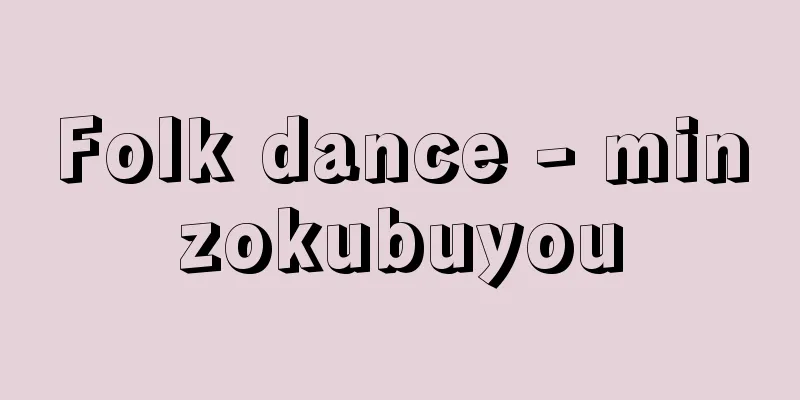Folk dance - minzokubuyou

|
A general term for dances based on ethnic groups or nations formed by those ethnic groups. Ethnic dance is a translation of the English term ethnic dance, and is different from folk dance, which is a translation of folk dance or country dance. In the West, the term ethnic dance often includes nuances of non-Western, non-Christian, and exotic. There is a lot of overlap between ethnic dance and folk dance, making it difficult to make a strict distinction, but it would be appropriate to call dances that are indigenous to each region folk dance, while dances that represent each ethnic group folk dance. For example, kabuki dance is an ethnic dance because it is danced by the Japanese people, but it is not a folk dance because it is a genre of Edo urban culture and has never been danced in the countryside. On the other hand, Hayachine Kagura from Iwate Prefecture is an ethnic dance by the Japanese people, but it is also a folk dance because it is performed as a seasonal event in the countryside. [Masa Ichikawa] Comparison between East and West, class and cultural sphereIt is said that Eastern dance generally involves a lot of arm and hand movements, while Western dance involves a lot of foot movements. Hand expression is important in dances such as Kabuki and Indian Kathakali, which tell a story through dance, but dances that lack a story, such as European folk dance, do not require hand expression and active foot movements are important. However, it is said that in both Eastern and Western dances, the dances of commoners involve active foot movements, while dances that developed in upper class society such as at the imperial court involve slower movements and more hand expression. This is clear when comparing Nembutsu dance with Bugaku and Noh. It is not possible to conclude that Eastern dance places more emphasis on the hands and Western dance places more emphasis on the feet. What is more important is that while in Eastern folk dances dancers do not hold hands, in Western dances dancers often hold hands and touch each other's bodies. In flamenco from Andalusia in southern Spain, which is heavily influenced by Islamic culture, men and women may be close to each other but do not touch, but in the Catalonia region of Spain, which is also a Christian cultural area, men and women form a circle and hold hands when dancing the sardana. Rather than comparing the East and the West, it may be clearer to compare the dances of Christian cultural areas with those of Islamic, Hindu, and Buddhist cultural areas. [Masa Ichikawa] East AsiaIn Japan, gagaku, noh, and kabuki were perfected in ancient times, the Middle Ages, and early modern times, respectively, and are still often performed today. gagaku, which was introduced from the continent, is a slow, whirling dance, also called bugaku. Noh developed and refined from sangaku, which also came from the continent, and is based on a dance that uses sliding movements of the whole body with sliding feet. In kabuki, which developed from nembutsu dance, the dance-based parts are called shosagoto, and there is a strong element of furi, which expresses the meaning of the lyrics with movements that are like those of a person trying to guess something. This kabuki dance is the Japanese dance that represents the Japanese people in the narrow sense. Folk performing arts (folk dances) that are handed down throughout Japan include kagura, furyu, lion dance, and dengaku. Korea has court dances and folk dances, with court dances such as Gagaku, Tang music, and Hyang music, and folk dances such as Mu Danchium, known as folk shamanism, Buddhist monk dance, Namsadang, a satirical masked play and traveling performers, and Farmers' music. China has dance dramas such as Peking Opera and Sichuan Opera, and works such as Journey to the West include acrobatic performances and dances, making them very spectacular. As the country is large, there are many folk dances, including the lion dances and sword dances of the Han people, the duet dances of the Akha people of Yunnan Province similar to Japan's Utagaki, and the round dances of the Uyghur region. [Masa Ichikawa] Southeast AsiaDance dramas based on the ancient Indian epics Ramayana and Mahabharata are widespread throughout Indonesia, Thailand, and Burma (Myanmar). Slimpi, from Java, Indonesia, is a court dance that gracefully expresses Persian stories through gestures. Also, on the island of Bali in Indonesia, there are the Legong, which is danced by three girls in a state of ecstasy, the Barong dance, which is an exorcism of the witch Randa, and the Kecak, which is danced by a chorus of men. Thai court dance includes the Khon, which is based on the Ramayana. The costumes are beautifully decorated, and the main character appears wearing a tower-shaped crown. It is an extremely slow dance with the hands bent back. Burma also has That Pue, which is based on the Ramayana. Religious elements such as Islam and Hinduism remain strong in Southeast Asian dance. [Masa Ichikawa] South AsiaIndian classical dances that originated in temples and are now performed in theaters include Kathakali from Kerala, Odisha, Manipuri, Kathak from around Delhi to Rajasthan, and Bharata Natyam from around Chennai (Madras). All of them are based on the oldest Indian scripture, Rig Beta, and the epics Ramayana and Mahabharata. These dances are performed barefoot, with bells rang, and hand movements are used to depict the story through gestures. Indian folk dances are performed at seasonal festivals or when invited to exorcise demons. Chhau from West Bengal is performed as part of ethnic festivals based on the belief in Shiva, and dances in which the South Indian earth goddess Bakabati appears and possesses the body are performed to pray for the fertility of the earth. Sri Lanka has a dance for exorcism called the Besudance, which is performed by a specialized group and features vigorous gyrations. Kandyan dance, which is performed in the procession of the Perahera festival, is also famous. [Masa Ichikawa] OceaniaThis area is broad and is divided into Micronesia, Melanesia, and Polynesia. The Micronesian island of Palau has a war dance similar to the stick dance of Kagoshima, which is thought to have a connection to Japan. The Polynesian island of Tahiti has a dance called 'otea, in which men and women form a line and dance while vigorously shaking their buttocks, which can be said to be similar in form to the hula dance of Hawaii, also in Polynesia. The indigenous people of New Guinea in Melanesia also have their own dances, and the masked war dance of the indigenous people (Aborigines) of northern Australia, which can be considered a mock war, is famous. In the Trobriand Islands, which anthropologist Marcel Mauss investigated, there is a folk dance in which a man approaches a group of women and the women push him back, and based on this dance, airplanes and other things brought by Western civilization are imitated in dance and performed at festivals. [Masa Ichikawa] EuropeBecause medieval Christian society rejected dance, the folk dances of Europe, unlike those in Asia, had significantly fewer religious elements and were danced by the masses for their own enjoyment. Since the 16th century, known as the "century of dancing," various dances have become popular, but in the history of ballet, these are called pre-romantic dances. Folk dances such as the allemande, quadrille, gavotte, galiarda, courante, sarabande, gigue, chaconne, tarantella, passacaglia, paso doble, pavane, farandole, branle, boule, polka, bolero, polonaise, mazurka, and minuet were created one after another, and famous composers have used these as their themes. Dances that are still relatively commonly performed by the people today include the kolo, a round dance type from the Balkan countries; the csárdás, a Hungarian round dance performed by alternating men and women and consisting of sad parts and fast, rough parts; the fandango, which is danced with castanets at festivals in the Andalusia region of Spain, and the jota, which is danced at festivals in the Aragon region of the same country. [Masa Ichikawa] AfricaReligious and magical dances are seen in many parts of Africa, and are an essential part of festival rituals. Dances are used in Africa to overcome critical times, for example, to cure illness, initiation ceremonies for girls to become adults, funerals, and for successful hunting. Masked dances are common along the west coast of Africa, from the Dogon people of Central Africa to the Baule people of Nigeria, and their masks vary from long to flat. Researchers say that African dance is polycentric in terms of movement. The hands and feet move independently, and this is particularly prevalent among the ethnic groups of East Africa, such as Kenya, Zambia, and Tanzania. An example of a magical dance is the healing dance of the San people of Botswana. A sick person crouches in the center of a circle, and the male dancers repeat simple rhythmic steps along the circle. It is believed that the sick person was hit by an arrow shot by the devil, and the men go and touch the sick person from time to time, hoping to give him the magical powers they have gained while dancing. This dance is performed throughout the night. [Masa Ichikawa] North AmericaNorth American folk dances include jazz dance and Native American (American Indian) dances. In the late 19th century, after the abolition of slavery, black people in America danced in public squares in the African dances of their birth, such as the Congo shuffle. The shuffle means dragging one's feet, and is a unique way of walking for black people. Similarly, the cakewalk involves walking with a water jar on one's head and leaning back rhythmically in a pretentious manner, and is so named because cakes were given out as prizes. Such black dances evolved into jazz dance through soft shoe dancing and tap dancing in minstrel shows. The jazz dance seen on stage today was created based on steps created during the Jazz Age, and has become an indispensable part of Broadway musicals. Many Native Americans live on reservations, and rituals and the associated dances are less common, but some of the more well-known dances are the Sioux bear dance, the Dakota buffalo dance, the Apache clown dance, the Hopi eagle dance, and the Navajo fire dance. The Hopi are based in Arizona, where they hold rain-making ceremonies due to the scarcity of rain, and the snake dance is performed on the final day of the ceremony. In this ceremony, the ancestral spirit Kachina visits wearing a mask, promising fertility and rain. [Masa Ichikawa] latin americaNot only North America, but also the indigenous peoples of Latin America (American Indians) such as Mexico, Guatemala, and Bolivia each have their own unique folk dances. The coyote dance of the Yaqui Indians of Mexico is performed by three men dressed as coyotes, wearing eagle feathers on their heads and coyote skins, who dance monotonously all night long in a crouched position with their knees relaxed. This is probably due to the belief that the coyote is an ancestral animal. Latin America also has a thriving Afro-American folk dance, which is a fusion of African dances and Latin rhythms such as those from Spain, such as Cuba's bolero, habanera, rumba, cha-cha-cha, and mambo, Brazilian samba, and Argentine tango. Dance developed as a part of religious rituals, and communities in which people lived entrusted their collective aspirations to rituals. These communities were tribes and ethnic groups. Folk dance was an indispensable part of these rituals. It was also more expressive than language and was an important means of communication. The value of folk dance is much higher than we modern people think. In recent years, physical culture as a medium of non-verbal communication has been reevaluated, and research into dance ethnology and dance anthropology has become more active. The dance section of the International Theatre Institute (ITI) has held festivals and symposiums on Philippine folk dance, as well as symposiums on Roma and Indian dance, and Japanese folk performing arts scholars have traveled to China and Korea to conduct research, leading to the creation of comparative ethnodance studies. Outside of Japan, J. Hanna, P. Reuss, G. Klaas, and J. Chiarinohomoc have each published papers based on field research in various locations. [Masa Ichikawa] "World Dance History" by C. Sachs, translated by Ogura Shigeo (1972, Ongaku No Tomosha)" ▽ "Folk Dance: Ethnic Character and Dance Technique" by J. Lawson, translated by Morishita Harumi (1975, Taishukan Shoten)" ▽ "Sacred Dance" by M. Vaugin, translated by Ichikawa Masa (1981, Heibonsha)" ▽ "Everything You Need to Know About the World's Ethnic Dances" by Miyao Yoshiyoshi (1998, Shinshokan) [References] | | | | | | | | | | | |Take Kagura is a dance handed down in the Take area of Oosakocho, Hanamaki City. It is a wild and heroic dance, and is performed at the annual festival of Hayachine Shrine. Hayachine Kagura was registered as an intangible cultural heritage by UNESCO in 2009. Nationally designated important intangible folk cultural property Hanamaki City, Iwate Prefecture © Hanamaki Tourism Association Hayachine Kagura Korean classical dance. The performers wear a hat called a senkasa and hold daggers in both hands. ©Shogakukan "> Sword dance (Kuoumum) Korean folk dance. The dancers play the traditional Korean double-sided drum, the jogaku. ©Shogakukan "> Janggochum (Staff Dance) A folk art from Bali, Indonesia. A woman dances in the center while a chorus of men sit in a circle and sing. ©Shogakukan "> Ketchup A representative classical dance of Thailand. It is a court dance drama based on the ancient Indian epic poem "Ramayana" ©Shogakukan "> cone Cambodian classical dance. It is characterized by gorgeous costumes, relaxed movements and graceful finger movements. ©Shogakukan "> Apsara Dance A folk dance from Kandy, central Sri Lanka. The photo shows a male dancer wearing ornaments. It is performed at the Perahera Festival, held every August. ©Shogakukan "> Kandyan Dance This is a folk dance handed down in French Polynesia and the Society Islands, including Tahiti. Dancers vigorously move their hips to the accompaniment of percussion instruments. The photo shows Moorea, an island close to Tahiti . Otea Papua New Guinea's war dance. The costumes vary from tribe to tribe, reflecting the diversity of the tribes. ©Shogakukan "> Shinshin This is a war dance by the Maori, the indigenous people of New Zealand. It is characterized by powerful movements, shouts, and unique gestures such as opening the eyes wide and sticking out the tongue. ©Shogakukan "> fool A musical dance from the Andalusian region of southern Spain. The dance itself is musical, with elements such as pitos (finger clapping), palmas (hand clapping), and zapateado (foot stomping). Seville, Spain ©Shogakukan "> flamenco Source: Shogakukan Encyclopedia Nipponica About Encyclopedia Nipponica Information | Legend |
|
民族あるいはその民族によって形成される国家を単位にした舞踊の総称。民族舞踊は英語のエスニック・ダンスethnic danceの訳語であり、フォーク・ダンスfolk danceあるいはカントリー・ダンスcountry danceの訳語である民俗舞踊とは異なる。欧米でエスニック・ダンスという場合、西洋以外の、非キリスト教的、異国風のというニュアンスが含まれることが多い。民族舞踊と民俗舞踊とは重複する部分も多く、厳密な区別はしにくいが、各地方の土俗的な舞踊を民俗舞踊とよぶのに対して、各民族を代表する舞踊を民族舞踊というのが妥当であろう。たとえば、歌舞伎舞踊(かぶきぶよう)は日本民族によって踊られるので民族舞踊であり、江戸の都市文化の一ジャンルであり、地方で踊られたことがないので民俗舞踊ではない。一方、岩手県の早池峰神楽(はやちねかぐら)は日本民族による民族舞踊であると同時に、地方で季節の行事として行われるために民俗舞踊でもある。 [市川 雅] 東洋と西洋、階層、文化圏による比較東洋の舞踊は一般的には腕や手の動きが多く、西洋の舞踊は足の動きが多いといわれている。物語を舞踊によって語る歌舞伎やインドのカタカリなどは手による表現が重要であるが、ヨーロッパの民族舞踊のように物語を欠いているものは手の表現を必要とせず、活発な足の動きが重要となる。しかし、東洋・西洋ともに庶民の舞踊は足が活発に動き、宮廷など上流社会で発達した舞踊は緩慢な動作で手の表現が多いといわれている。舞楽や能に対して念仏踊などを比較すれば明らかである。一概に東洋の手の重視と西洋の足の重視を結論することはできない。 むしろ重要なのは、東洋の民族舞踊が互いに手を取り合わないのに反し、西洋の舞踊は互いに手を取り合い、相手の身体に触れたりすることが多いことである。イスラム文化の影響を色濃く残すスペイン南部アンダルシア地方のフラメンコは、男女が近接こそすれ、触れることはないが、キリスト教文化圏の同じスペインのカタルーニャ地方では、サルダーナを踊るときに男女が輪になり手を取り合う。東洋・西洋という比較ではなく、キリスト教文化圏とイスラム・ヒンドゥー・仏教文化圏の舞踊を比較したほうが明解であるかもしれない。 [市川 雅] 東アジア日本では、雅楽、能、歌舞伎が古代、中世、近世にそれぞれ完成し、現在も上演される機会も多い。大陸から伝来した雅楽は舞楽ともいわれるように緩慢に旋回する舞である。能は同じく大陸からの散楽(さんがく)から発達して洗練されたもので、摺(す)り足による体全体の滑るような動きの舞を基本としている。念仏踊から発達した歌舞伎では、舞踊が主体の部分を「所作事(しょさごと)」といい、歌詞の意味するところを物あてぶり的な動作で表現する「振(ふり)」の要素が強い。日本民族を代表する狭義の日本舞踊はこの歌舞伎舞踊である。なお、日本各地に伝承する民俗芸能(民俗舞踊)には、神楽、風流(ふりゅう)、獅子(しし)舞、田楽(でんがく)などがある。 朝鮮には宮廷舞踊と民俗舞踊があり、宮廷舞踊としては雅楽、唐楽(タンアク)、郷楽(ヒャンアク)など、民俗舞踊には民間のシャーマニズムとして知られる巫舞(ムーダンチウム)、仏教系の僧舞(スンム)、風刺的な仮面劇や旅芸人の男寺党(ナムサダン)、農楽などがある。中国には京劇や川劇(せんげき)といった舞踊劇があり、『西遊記』などの作品には軽業(かるわざ)的な演技と舞踊が含まれ、スペクタクル性が強い。民間の舞踊は国が広いだけに数多くあり、漢民族の獅子舞や剣舞、日本の歌垣(うたがき)に似た雲南省のアカ族の対舞、ウイグル地区の輪舞など数多い。 [市川 雅] 東南アジア古代インドの叙事詩『ラーマーヤナ』と『マハーバーラタ』に取材した舞踊劇がインドネシア、タイ、ビルマ(ミャンマー)一帯に広がっている。インドネシア、ジャワ島のスリムピはペルシアの物語を身ぶりで優雅に表現する宮廷舞踊である。また同国のバリ島には、3人の少女によって陶酔状態で踊られるレゴン、魔女ランダの悪魔祓(ばら)いであるバロン・ダンス、男たちの合唱で踊られるケチャなどがある。タイの宮廷舞踊には『ラーマーヤナ』を題材にしたコーンがある。衣装はきれいな装飾が施され、主役は塔状の冠を着けて登場する。手を反らしたきわめて緩やかな踊りである。ビルマにも『ラーマーヤナ』を題材にしたザット・プーエがある。東南アジアの舞踊は、イスラム教やヒンドゥー教など宗教的要素が色濃く残っている。 [市川 雅] 南アジア寺院などで発生し、いまでは劇場などで上演されるインド古典舞踊に、ケララ州のカタカリ、オリッサ州のオディシー、マニプル州のマニプリ、デリー周辺からラージャスターン州にかけてのカタック、チェンナイ(マドラス)近辺のバーラタ・ナーティヤムなどがある。いずれもインド最古の聖典『リグ・ベータ』や叙事詩『ラーマーヤナ』『マハーバーラタ』などを題材にしている。これらの舞踊は裸足で足を踏み、鈴を鳴らしたりして踊られ、身ぶりで物語を描写するために手の動きが用いられる。インドの民俗舞踊は季節の祭りに行われたり、悪魔を祓(はら)うために招かれて演じられる。西ベンガル州のチョウなどはシバ神への信仰を基にした民族の祭りの一部として行われ、南インドの地母神バカバッティが登場し憑依(ひょうい)する舞踊も大地の肥沃(ひよく)を祈念するものとして演じられる。 スリランカにはベスダンスとよばれる悪魔祓いの舞踊があり、専門集団によって踊られ、激しい旋回を特徴としている。ペラヘラ祭の行列のなかで踊られる同国のキャンディアン・ダンスなども有名である。 [市川 雅] オセアニアこの区域は広く、ミクロネシア、メラネシア、ポリネシアに分かれている。ミクロネシアのパラオ島には鹿児島の棒踊りに似た戦闘舞踊があり、日本との関係が推定される。ポリネシアのタヒチ島にはオテアとよばれる、男女が列をつくって尻(しり)を強く振って踊る舞踊があり、同じポリネシアのハワイ島のフラ・ダンスに似た形式といえる。メラネシアのニューギニアの先住民にも独自の舞踊があり、オーストラリア北部の先住民(アボリジニー)の仮面をかぶっての擬似戦争ともいえる戦闘舞踊は有名である。人類学者マルセル・モースが調査したトロブリアンド島には、男が女の集団に迫り、女がそれを押し戻すような民族舞踊があり、またその舞踊を基調にして、西洋文明がもたらした飛行機などが舞踊で模擬され、祭りで演じられたりしている。 [市川 雅] ヨーロッパ中世キリスト教社会が舞踊を排除したことなどから、ヨーロッパ各地の民族舞踊はアジアなどと違って宗教的な要素が著しく少なくなり、民衆が自ら踊って楽しむものになっている。「踊る世紀」とよばれた16世紀以降、さまざまな舞曲が流行したが、これらはバレエ史のなかではプレ・ロマンチック・ダンスといわれている。アルマンド、カドリーユ、ガボット、ガリアルダ、クーラント、サラバンド、ジーグ、シャコンヌ、タランテラ、パッサカリア、パソ・ドブレ、パバーヌ、ファランドール、ブランル、ブレー、ポルカ、ボレロ、ポロネーズ、マズルカ、メヌエットなどの民族舞曲が次々と生まれ、著名な作曲家がこれらを題材としてきた。現在も民衆によって比較的多く踊られているものに、バルカン半島諸国の輪舞型式のコロ、悲哀を帯びた部分と急速で荒々しい部分からなり男女交互のハンガリーの輪舞チャールダーシュ、スペインのアンダルシア地方の祭りでカスタネットを持って踊られるファンダンゴ、同国のアラゴン地方の祭りで踊られるホタなどがある。 [市川 雅] アフリカアフリカでは宗教的、呪術(じゅじゅつ)的な舞踊が各地でみられ、祭りの儀式の一部として必要なものになっている。舞踊はアフリカでは危機的な時間を超えるために用いられる。たとえば病気の治療、娘から成人への入会式、葬礼、狩猟が成功するために、などである。中央アフリカのドゴン人からナイジェリアのバウレ人などアフリカ西海岸にかけて仮面舞踊が多く、その仮面は長いものから平べったいものまでさまざまである。研究家たちはアフリカ舞踊の特徴を動きの点からみると多中心的だという。手や足などがばらばらに動くということで、とくに東アフリカのケニア、ザンビア、タンザニアなどの諸民族にそれが多いといわれている。 呪術的な舞踊の例としてボツワナのサン人の治療舞踊をあげてみよう。病人が円陣の中心にうずくまり、男の踊り手たちは円に沿って単純なリズミックな歩行を繰り返す。病人は悪魔が放った矢が当たって病気になったと信じられており、男たちは踊りながら得た呪術的な力を病人に手渡そうとして、ときどき病人に触りに行く。この踊りは夜通し行われる。 [市川 雅] 北アメリカ北アメリカの民族舞踊としては、ジャズ・ダンスと先住民(アメリカ・インディアン)の舞踊があげられる。19世紀後半、奴隷解放後のアメリカでは、黒人が広場などで、自分の出生地であるアフリカの舞踊、コンゴ・シャッフルなどを踊った。シャッフルとは足を引きずることをいい、黒人独特の歩行の仕方であった。同じくケーク・ウォークは、水甕(みずがめ)を頭にのせて気どってリズミックにのけぞったりして歩くもので、ケーキが賞品として出たことからこの名がある。そうした黒人の踊りはミンストレル・ショーでのソフトシューズ・ダンス、タップ・ダンスなどを経てジャズ・ダンスに発展した。現在、舞台でみられるジャズ・ダンスはジャズ・エイジにつくられたステップを基本に創作されたもので、ブロードウェーのミュージカルにはなくてはならないものとなっている。 先住民(アメリカ・インディアン)の多くは居留地で生活し、儀式やそれに伴う舞踊が行われることが少なくなっているが、スーの熊(くま)の舞踊、ダコタの野牛の舞踊、アパッチの道化舞踊、ホピの鷲(わし)の踊り、ナバホの火の踊りなどが有名である。ホピはアリゾナ州を本拠としており、降雨の少ないことから雨乞(ご)いの儀式を行い、蛇の舞踊が儀式の最終日に行われる。祖霊カチナが仮面を着けて来訪し、豊穣(ほうじょう)と降雨を約束する儀式である。 [市川 雅] ラテンアメリカ北アメリカだけでなく、メキシコ、グアテマラ、ボリビアなどラテンアメリカの先住民(アメリカ・インディアン)も、それぞれ固有の民族舞踊をもっている。メキシコのヤキ・インディアンのコヨーテの踊りは、コヨーテに扮(ふん)した3人の男たちが頭に鷲の羽をかぶり、コヨーテの皮を着け、かがんだ姿勢で膝(ひざ)を緩めて一晩中単調に踊る。コヨーテを祖霊動物とみる信仰からきているのだろう。またラテンアメリカには、キューバのボレロ、ハバネラ、ルンバ、チャチャチャ、マンボ、ブラジルのサンバ、アルゼンチンのタンゴなど、アフリカからもたらされたものとスペインなどラテン系のリズムの融合による、アフロ・アメリカンとよばれる民族舞踊が盛んである。 舞踊は宗教的儀礼の一部として発達し、人々の住むコミュニティは集団的願望を儀式に託して生きてきた。そのコミュニティは部族であり民族であった。民族舞踊はそれらの儀式にはなくてはならないものであった。また、言語以上に表現力があり、たいせつなコミュニケーションの方法であった。民族舞踊の価値は私たち現代人が考えている以上に高いものであった。 近年、ノンバーバル(非言語)・コミュニケーションのメディアとしての身体文化が見直されるようになり、舞踊民族学、舞踊人類学の研究も盛んになっている。国際演劇協会(ITI)の舞踊部会でも、フィリピンの民族舞踊のフェスティバルやシンポジウム、ロマやインドの舞踊のシンポジウムなどが行われており、日本の民俗芸能学者も中国や朝鮮に出向いて研究しており、比較民族舞踊学が構想されている。外国ではJ・ハンナ、P・ロイス、G・クラース、J・キアリノホモクなどが、それぞれ各地のフィールド調査を踏まえて論文を発表している。 [市川 雅] 『C・ザックス著、小倉重夫訳『世界舞踊史』(1972・音楽之友社)』▽『J・ローソン著、森下はるみ訳『フォークダンス 民族性と舞踊技術』(1975・大修館書店)』▽『M・ヴォージン著、市川雅訳『神聖舞踏』(1981・平凡社)』▽『宮尾慈良著『これだけは知っておきたい世界の民族舞踊』(1998・新書館)』 [参照項目] | | | | | | | | | | | |花巻市大迫町岳地区に伝わる岳神楽。荒々しく勇壮な舞で、早池峰神社の例祭などで演じられる。早池峰神楽は2009年(平成21)にユネスコ無形文化遺産に登録された。国指定重要無形民俗文化財 岩手県花巻市©一般社団法人花巻観光協会"> 早池峰神楽 韓国の古典舞踊。戦笠とよばれる帽子をかぶり、両手に短剣を持つ©Shogakukan"> 剣舞(クゥオムム) 韓国の民族舞踊。代表的な朝鮮の両面太鼓である杖鼓を打ち鳴らしながら舞う©Shogakukan"> 杖鼓舞(チャンゴチュム) インドネシア、バリ島の民族芸能。円形に座った男性たちの合唱に合わせ、中央で女性が舞う©Shogakukan"> ケチャ タイを代表する古典舞踊。インドの古代叙事詩『ラーマーヤナ』を題材にした宮廷舞踊劇である©Shogakukan"> コーン カンボジアの古典舞踊。きらびやかな衣装、ゆったりとした動作としなやかな手指の動きが特徴である©Shogakukan"> アプサラ・ダンス スリランカ中部、キャンディの民族舞踊。写真は、飾り物を身につけた男性の踊り手。毎年8月に開催されるペラヘラ祭で踊られる©Shogakukan"> キャンディアン・ダンス フランス領ポリネシア、タヒチ島をはじめとするソシエテ諸島の島々に伝わる民族舞踊。打楽器の伴奏に合わせ、腰を激しく動かして踊る。写真は、タヒチ島に近接するモーレア島©Shogakukan"> オテア パプア・ニューギニアの戦闘舞踊。種族の多様性を反映して、衣装も種族ごとに異なる©Shogakukan"> シンシン ニュージーランドの先住民、マオリの戦闘舞踊。力強い動きや叫び声、目を見開き舌を突き出す独特の仕草などが特徴的である©Shogakukan"> ハカ スペイン南部、アンダルシア地方の音楽舞踊。ピトス(指打ち)、パルマス(手拍子)、サパテアド(足踏み)など、踊り自体が音楽性を備えている。スペイン セビーリャ©Shogakukan"> フラメンコ 出典 小学館 日本大百科全書(ニッポニカ)日本大百科全書(ニッポニカ)について 情報 | 凡例 |
>>: Ethnic clothing - Minzokufuku
Recommend
Pterois lunulata (English spelling) Pteroislunulata
…There are four species of lionfish in the Japane...
Echinocactus grusonii (English spelling)
... E . pentalophus var. procumbens (Eng.) Krainz...
National Industrial Recovery Act
...the abbreviation for the National Industrial R...
Enkato - Enkato
…The Japanese word toshi (city) was used in the m...
Jasper
A town in the western foothills of the Canadian Ro...
Heir (eldest son) - Onzoushi
A term used in the performing arts. Refers to the ...
Danburite (English spelling)
A mineral that often forms rhombic columnar cryst...
Hironaka Heisuke
Mathematician. Born in Yuu-cho, Kuga-gun, Yamaguc...
Megasthenes - Megasthenēs
A Greek who transmitted information on the geogra...
Hyaluronic acid
…Many of them have acidic groups such as uronic a...
Danmono - Danmono
A classification name for Japanese music. In prin...
Bion - Bion (English spelling)
Date of birth and death unknown. Ancient Greek pa...
Burhaneddin (English spelling)
1344‐98 A minor Anatolian prince and poet. He serv...
Physiography
…The purpose of physical geography is to describe...
Aburiko
...Even after the Date clan moved their base to S...









